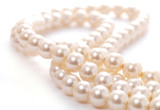The Difference Between Types of Pearls

There are several different types of pearls. If you’re thinking about buying some vintage jewellery for a gift, or for a treat for yourself, it’s worth knowing the difference. Here at Harrington & Co, vintage jewellery is our speciality. We know it inside out. Let’s find out a bit more about the difference between the types of pearls.
South Sea Pearls
South Sea pearls are a salt water pearl. They are grown in a large oyster, known as the Pinctada Maxima. They get farmed in Australia, Indonesia and the Philippines. They are a highly valuable pearl. Their value comes based on many factors. To start with, the oyster has to reach around four years of age before it can get seeded. Each oyster can only produce a single pearl, although some rare specimens can get seeded twice. This seeding is an advanced surgical technique that needs to get performed by an experienced technician. The colour of a South Sea Pearl comes determined by the interior of the oyster, and each pearl can develop differently. This means it can sometimes take a while to get a matching strand!
Tahitian Pearls
These stellar specimens are grown in the same manner as South Sea pearls. Yet the species of oyster they are grown in differs. They are grown in the black lipped oyster, which gives them their dark and smoky black and grey colour. They come named after Tahiti, although the majority of these pearls get farmed in the ocean around French Polynesia. Gem-quality Tahitian pearls are rare – in fact, less than 5% pass the strict quality control measures. Their high value is due to this factor.
Freshwater Pearls
Freshwater pearls get manufactured in China. Did you know that they grow in a mussel, instead of an oyster? This contributes to the lower value of the freshwater pearl. Each mussel can produce up to 40 or 50 pearls at a time. Freshwater pearls are also more likely to have blemishes and be odd-shaped. They are also often smaller. Their colour varies as well, and depends on the mussel although most get dyed to give them a uniform appearance.
Akoya Pearls
These beautiful gems are salt water pearls that are grown in Japan, China and India. They vary in size from 6-8mm. A Japanese researcher named Kokichi Mikimoto created them. They get seeded using a round mother of pearl bead and a tiny piece of living tissue. This gives them their uniform round colour. Each oyster can produce two pearls. While South Sea pearls have impacted the global sales of Akoya pearls, they can still fetch a hefty sum for a strand. Thousands of dollars in fact. Hopefully by now you’re well and truly informed about the differences between the types of pearls. South Sea are the most popular, and expensive, closely followed by Tahitian and Akoya. Freshwater pearls, due to their mass production - are the budget option.
